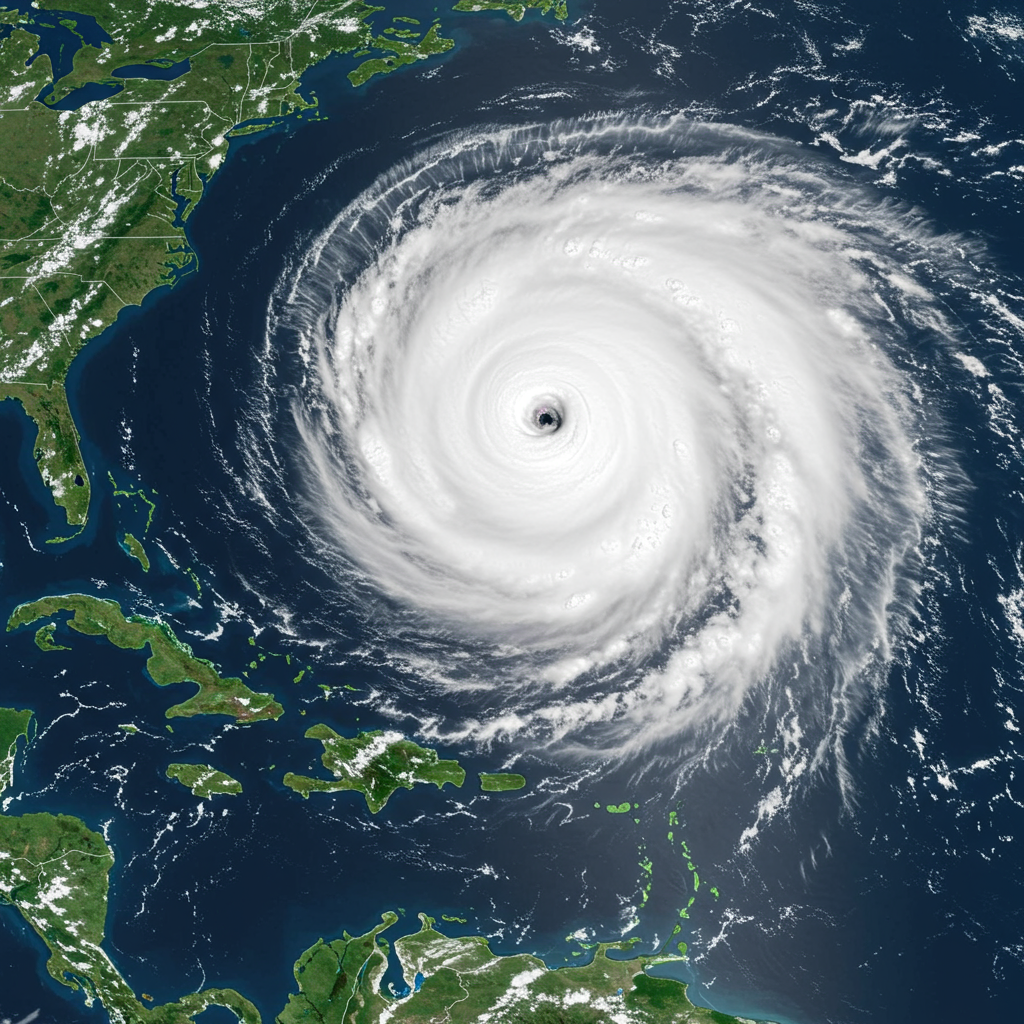The Atlantic has awakened with ferocity as Hurricane Erin rapidly escalated into a catastrophic Category 5 storm. This marks Erin as the first major hurricane of the 2025 Atlantic season, commanding urgent attention from the U.S. National Hurricane Center (NHC) and residents across the Caribbean and the U.S. East Coast. With maximum sustained winds nearing 160 mph (255 km/h), this powerful system demands immediate monitoring and preparedness. The storm’s swift intensification highlights the critical need for vigilance as it churns through the southwestern Atlantic.
Erin’s Explosive Intensification
Hurricane Erin has stunned meteorologists with its astonishing rate of intensification. From a tropical storm just a day prior, it swiftly surged to a dangerous Category 4, and then rocketed to a Category 5 hurricane on Saturday, August 16, 2025. This dramatic shift saw its wind speeds more than double in merely 24 hours. Mike Brennen, director of the National Hurricane Center, noted that Erin leapt from Category 2 to Category 5 within a mere nine hours, calling it a “very powerful hurricane.”
This rapid intensification (RI) is a worrying trend seen more frequently in recent hurricane seasons. Experts link this phenomenon to warmer-than-normal ocean temperatures, a clear signal of global heating. Erin’s minimum central pressure was recorded at a staggering 915 mb, further underscoring its immense power. Its compact nature at present is also a concern, as forecasts suggest it will expand significantly, potentially doubling or tripling in size over the next week, exacerbating rough ocean conditions.
Current Location and Projected Path
As of the latest NHC advisories on August 16, 2025, Hurricane Erin was located approximately 105 to 110 miles north of Anguilla. It was also about 205 miles east-northeast of San Juan, Puerto Rico. The storm is currently moving westward, a trajectory expected to continue through Saturday afternoon. A turn toward the west-northwest is anticipated by Saturday night, likely accompanied by a decrease in forward speed.
Looking ahead, Hurricane Erin is forecast to turn northward early next week. On its projected track, the eye of the hurricane is expected to pass just north of the northern Leeward Islands, the Virgin Islands, and Puerto Rico over the weekend. While strengthening is still anticipated through Saturday afternoon, fluctuations in intensity are possible for the remainder of the weekend. Forecast models predict the storm will eventually veer sharply to the northeast, passing between the U.S. East Coast and Bermuda around Monday.
Imminent Impacts on Caribbean Islands
The immense power of Hurricane Erin poses significant threats to several Caribbean islands and surrounding waters. Even as it brushes past, its outer rain bands have already begun affecting the northern Leeward Islands.
Key impacts expected include:
Heavy Rainfall: Expect 2 to 4 inches of rain across the northern Leeward Islands, the Virgin Islands, and Puerto Rico through Sunday. Isolated areas could see up to 6 inches, raising the risk of considerable flash flooding and urban flooding. Landslides and mudslides are also a serious concern in mountainous regions.
Dangerous Swells: Swells generated by Erin will affect portions of the northern Leeward Islands, the Virgin Islands, Puerto Rico, Hispaniola, and the Turks and Caicos Islands throughout the weekend. These dangerous swells will create rough ocean conditions and are expected to spread to the Bahamas, Bermuda, and the U.S. East Coast early next week, leading to life-threatening surf and rip currents.
Tropical Storm Watch: A Tropical Storm Watch is currently in effect for St. Martin, St. Barthelemy, and Sint Maarten, urging residents to prepare for tropical storm-force winds and associated hazards.
U.S. East Coast Outlook and Secondary Risks
While Hurricane Erin is not expected to make direct landfall on the continental United States, its distant influence will be felt. Forecast models generally agree that the storm will remain well east of the U.S. coastline. However, indirect effects will be notable.
Specific concerns for the U.S. East Coast include:
Life-Threatening Rip Currents: Atlantic beaches from Florida northward will experience dangerous surf and rip currents due to the hurricane’s distant swells. Coastal residents and visitors must exercise extreme caution near the water.
- Elevated Risk for Specific Coastal Areas: Accuweather analysis suggests that specific protruding U.S. coastal areas, such as North Carolina’s Outer Banks, Long Island, New York, and Cape Cod, Massachusetts, face a slightly higher risk of experiencing direct tropical storm or even hurricane conditions, compared to other parts of the broader southern Atlantic, mid-Atlantic, and northern New England coasts.
- www.staradvertiser.com
- www.fox35orlando.com
- www.theguardian.com
- www.nbcmiami.com
- www.yahoo.com
A unique and unforeseen secondary risk highlighted by meteorologists is the potential for wildfires. Andrew Siffert, a senior meteorologist at BMS Group, notes a dangerous alignment: if Erin evolves into a large, intense extratropical cyclone offshore, it could drive strong, dry winds across regions with critically dry fuels. Coupled with human ignition sources, this scenario significantly increases the risk of wildfires, even far from the storm’s center.
Widespread Preparedness and Response
In anticipation of Hurricane Erin’s impacts, governments and regional authorities have initiated extensive preparedness measures. The U.S. government has deployed over 200 employees from the Federal Emergency Management Agency (FEMA) and other agencies to Puerto Rico as a precautionary measure. A flood watch has been issued for the entire U.S. territory from late Friday through Monday, emphasizing the rain threat.
Ciary Pérez Peña, Puerto Rico’s Housing Secretary, confirmed that 367 shelters have been inspected and are ready for use if needed. The U.S. Coast Guard has also taken preventative action, closing six seaports in Puerto Rico and two in the U.S. Virgin Islands to all incoming vessels without prior authorization. Officials in the Bahamas have prepared public shelters and urged their citizens to closely monitor the hurricane’s progression. Aarone Sargent, managing director for the Bahamas’ disaster risk management authority, underscored the unpredictable nature of such storms and their capacity for “sudden shifts in movement.”
Broader Context of the 2025 Hurricane Season
Hurricane Erin is the fifth named storm of the 2025 Atlantic hurricane season, which typically runs from June 1 to November 30. It is notably the first system this year to achieve hurricane status, let alone Category 5 intensity. This season is projected to be unusually active, with forecasters anticipating between six and ten hurricanes, of which three to five are expected to reach major hurricane status (winds exceeding 110 mph). The rapid development of Erin reinforces these predictions, signaling the potential for a challenging hurricane season.
Frequently Asked Questions
How did Hurricane Erin intensify so quickly, and what are its primary dangers?
Hurricane Erin demonstrated exceptionally rapid intensification, escalating from a tropical storm to a Category 5 hurricane within 24 hours. Its wind speeds more than doubled, and it jumped from Category 2 to Category 5 in just nine hours. This swift growth is linked to warmer ocean temperatures. The primary dangers include catastrophic sustained winds, heavy rainfall leading to flash flooding, urban flooding, and landslides, and dangerous swells causing life-threatening surf and rip currents. There’s also a unique concern about wildfire risk if Erin transitions offshore.
Which regions are most directly affected by Hurricane Erin’s immediate path?
Hurricane Erin’s direct path is expected to pass just north of the northern Leeward Islands, the Virgin Islands, and Puerto Rico over the weekend. These islands will experience heavy rainfall and dangerous swells. Hispaniola and the Turks and Caicos Islands will also be affected by swells. Early next week, swells are projected to spread to the Bahamas, Bermuda, and the U.S. East Coast, leading to rip currents and rough surf, even without direct landfall.
What steps should residents in potentially affected areas take now to prepare for Hurricane Erin?
Residents in areas potentially affected by Hurricane Erin should immediately monitor official National Hurricane Center (NHC) advisories for the latest forecasts and warnings. Prepare for heavy rainfall by securing property and clearing drains. If in coastal areas, be aware of rip currents and dangerous surf, avoiding swimming during these conditions. Follow instructions from local authorities regarding evacuations or shelter openings. Have an emergency kit ready with essential supplies, and know your family’s communication and evacuation plan.
Conclusion
The sudden and dramatic intensification of Hurricane Erin into a catastrophic Category 5 storm serves as a stark reminder of nature’s immense power. While the direct impacts are most severe for the northern Caribbean islands, its influence, particularly through dangerous swells and rip currents, will extend to the U.S. East Coast. This event underscores the importance of staying informed and prepared throughout the entire hurricane season. Continuous monitoring of official updates from the NHC and local authorities is crucial for everyone in the projected path and affected coastal regions. Prioritizing safety and preparedness can make a significant difference in mitigating risks posed by such powerful storms.



